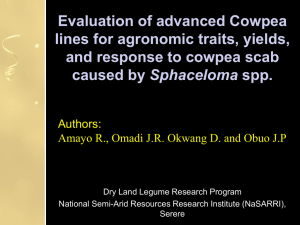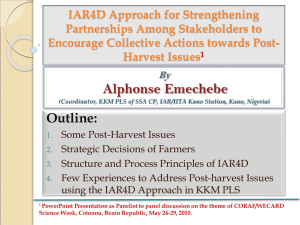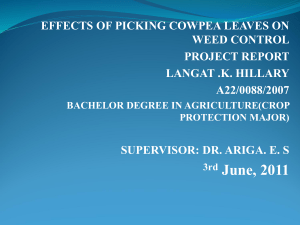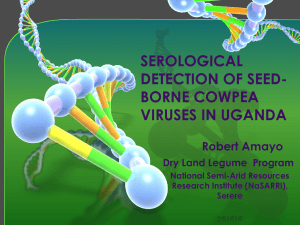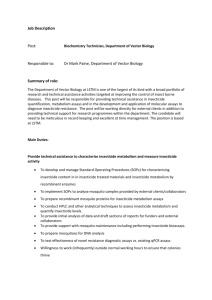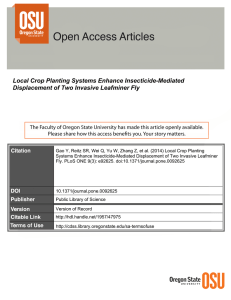S/N NAME REG.NO. TITLE OF THESIS YEAR ABSTRACT AREA
advertisement
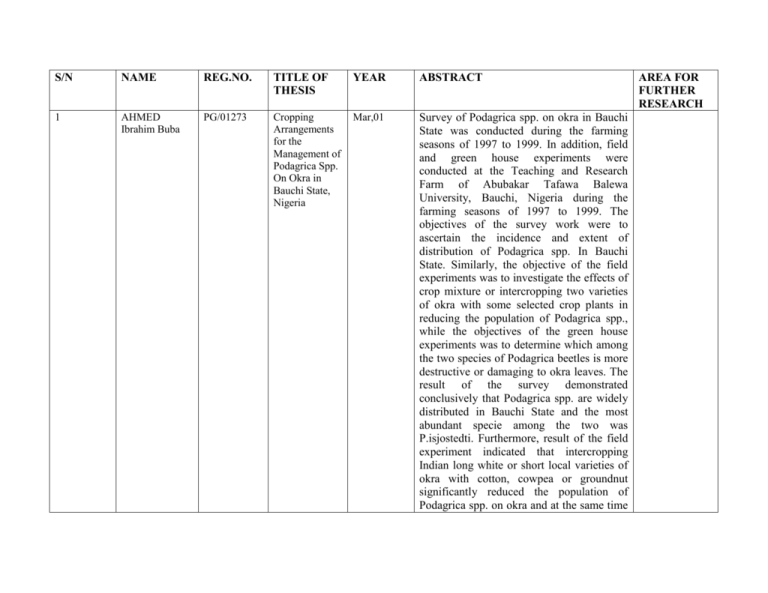
S/N
NAME
REG.NO.
TITLE OF
THESIS
YEAR
ABSTRACT
1
AHMED
Ibrahim Buba
PG/01273
Cropping
Arrangements
for the
Management of
Podagrica Spp.
On Okra in
Bauchi State,
Nigeria
Mar,01
Survey of Podagrica spp. on okra in Bauchi
State was conducted during the farming
seasons of 1997 to 1999. In addition, field
and green house experiments were
conducted at the Teaching and Research
Farm of Abubakar Tafawa Balewa
University, Bauchi, Nigeria during the
farming seasons of 1997 to 1999. The
objectives of the survey work were to
ascertain the incidence and extent of
distribution of Podagrica spp. In Bauchi
State. Similarly, the objective of the field
experiments was to investigate the effects of
crop mixture or intercropping two varieties
of okra with some selected crop plants in
reducing the population of Podagrica spp.,
while the objectives of the green house
experiments was to determine which among
the two species of Podagrica beetles is more
destructive or damaging to okra leaves. The
result of the survey demonstrated
conclusively that Podagrica spp. are widely
distributed in Bauchi State and the most
abundant specie among the two was
P.isjostedti. Furthermore, result of the field
experiment indicated that intercropping
Indian long white or short local varieties of
okra with cotton, cowpea or groundnut
significantly reduced the population of
Podagrica spp. on okra and at the same time
AREA FOR
FURTHER
RESEARCH
2
YUSUF Sani
Ringim
PGS/103006
Infestation and
Damage by
Maruca Vitrata
on some
Cowpea Lines
under different
Cropping
Systems in
Kano, Nigeria
Oct,05
increased the yield of okra plant. Similarly,
a result of green house experiments showed
that P sjostedti was more destructive than
P.uniforma in terms of foliage damage.
Result of the survey work recommends
detailed study of the biology and ecology of
Podagrica spp. with a view to identify the
natural enemies of Podagrica spp. and also
to ascertain/ determine the factors
responsible for the marked scarcity of P.
uniforma in the State. Results of field
experiment strongly recommend the
intercropping of okra with cotton, cowpea or
groundnut for maximum protection of the
plant against Podagrica spp. while green
house experiment recommends further
studies with a view to identify natural
enemies of Podagrica spp.
Field trials were conducted during rainy
season from 2001 to 2003 at the research
farm of the International Institute of
Tropical Agriculture (IITA), located at
Minjibir near Kano. A total of seventy five
(75) elite cowpea lines designated as groups
I (extra early), II (early), III (semi
determinate and early), IV (erect and
medium) and V (semi determinate and
medium) maturing were planted as sole
crops in a randomized completely block
design with three replications and screened
for resistance to Maruca vitrata (Fabricius)
damage without insecticide protection in
2001. Out of these, two promising cowpea
Further studies
should he
conducted in
the following
areas;
-To
further
increase
the
efficiency of
the 2:4 strip
mixture, there
is the need to
determine the
appropriate
time in which
the compatihle
lines, viz:
IT93K-452-1 and IT97K-499-38, with a
significant performance, a cowpea line
(IT90K-277-2) already released to farmers
by IITA and a local Dan'ila, were evaluated
in 2002 and 2003 for infestation and
damage by M vitrata as well as for grain
yield under strip-crop having 2-rows
sorghum: 4-rows cowpea, the traditional
inter-crop involving l-sorghum row: 1cowpea row and as sole-crop systems, with
and without insecticide application. The
insecticide
treated
and
untreated
experiments were each laid out in a splitplot design with four replications. All the
data obtained were subjected to analysis of
variance using SAS computer statistical
software, and significantly different
treatment means were separated using
Student-Newman-Keuls multiple range test
at 5% probability level. Results of this
investigation revealed that larval infestation
and damage to cowpea flowers and pods, as
well as damage severity in pods were not
significantly affected by sole, 1:1 inter or
2:4 strip-cropping system with and without
insecticide application. Two sprays of
insecticide remarkably reduced the level of
infestation and damage in cowpea by M
vitrata larvae in all the three cropping
systems. Although a relatively high larval
infestation and damage to Sowers in IT97K499-38, the line had lesser pod damage than
cowpea
crop
should
he
planted.
-Detailed study
should he
carried out on
the best time
for the
application of
insect control
measure on the
cowpea crop.
others in each of the three cropping systems
excluding Dan'ila under 1: 1 inter and 2:4
strip-crop mixtures with and without
insecticide application In 2002 and 2003,
cowpea grain yield differed significantly
among the three cropping systems with
insecticide treatment, and only in 2003
without treatment. Higher grain yield in
grams/hill was produced by the solecropped cowpea system with insecticide
application, but it was however, statistically
comparable to that of 2:4 strip-crop, but
each had significantly higher cowpea grain
yield than 1: 1 inter-crop system However,
the grain yield in 1: 1 inter-crop was higher
but did not differ from that of sole-crop
system when no insecticide was used, and
the former most effective in reducing loss in
grain weight than others. IT97K-499-38
gave very high grain yield with insecticide
treatment in 2002 and 2003, as well as
lower but reasonable yields when no
insecticide was used. Cowpea fodder yield
was significantly higher (P<0.001) in the
sole crop system, with and without
insecticide application. Local Dan'ila as a
sole-crop had the highest fodder tonnage
and lowest grain yield than others with and
without insecticide application. Cost-benefit
analysis showed that net profit was derived
from only IT97K-499-38 under sole and 2:4
strip-crop
systems
with
insecticide
treatment, while a net loss was incurred in
3
Dungum
Mainngwa
Selzing
PG/9899/103026
Potential of
Some Plant
Materials for
the control of
field insect
Pests of
Cowpea at
Bauchi, Nigeria
Feb,07
all the cowpea lines when put in 1: 1 intercrop mixture with and without insecticide
treatment. Results further indicated that the
populations of four natural enemies of M.
vitrata larvae on cowpea viz: Phanaretoma
leucobasis Kriechbaumer, Braunsia kriegeri
Enderlein, tachinid fly and a mermithid
nematode, were affected by insecticide
application in all the three cropping
systems, and the 1:1 inter-crop followed by
the 2:4 strip-crop systems attracted much
higher population of these organisms than
the sole cropped cowpea. Thus, given all
these benefits derivable from an integrated
approach system, it is recommended that the
resource poor farmers should be encouraged
to adopt the practice of planting 2 rows of
sorghum with 4 rows of IT97K-499-38 with
two sprays of insecticide for increased grain
and moderate fodder yields, besides the
better yield of the component cereal crop.
Field pests' studies were carried out at the
Teaching and Research Farm of Abubakar
Tafawa Balewa University, Bauchi during
the 2000, 2001, 2002 and 2005 cropping
seasons. Extracts of ten plants including,
Eucalyptus camadulensis Dehn., Hyptis
suaveolens Poit, Citrus aurantifolia
Swingle, Capsicum frutescens Linn.,
Zingiber :.{ficinale Roscoe, Cymbopogon
citratus Staph., Anona reticulata Pers.,
Carica
papaya
Linn.,
Anacardium
occidentale Lin., and Azadirachta indica
(A.) Juss. were tested on cowpea insect
pests. The objectives of the research were to
evaluate the potential of these plant
materials and to compare their efficacy with
a synthetic insecticide (karate") in reducing
the population density of insect pests of
cowpea (variety- SAMPEA-7). The design
of experiment was a randomized complete
block with four replications. The plot size
was 5 m x 5.25 m. Plant materials involving
fruit/seeds were applied at 10% w/v while
leaves were applied at 20% w/v. All the
plant materials tested including synthetic
insecticide (Karate") exhibited significant
(P<0.05) protection of cowpea flowers,
pods and seeds from thrips, Megalarothrips
sjostedti Trb., legume pod borer, Maruca
vitrata fab. and pod-sucking bugs damage
compared with the untreated control.
Among the pod sucking bugs species
sampled on cowpea with respect to their
relative abundance, clavigralla species was
the most predominant throughout the
spraying periods while nezara viridula was
the least. Among the plants extracts tested
those of A. indica, A. reticulata and A.
occidentale performed better compared to
materials of other plants used during in the
different study years. Synthetic insecticide
(Karate®) applied at 20g a.i /ha _was
superior to all the plant materials tested.
The effectiveness of A. indica, A. reticulata
and occidentale in curtailing insect pests on
4
Yusuf
Abdulhameed
Umar
PGS/0001/103077
Bioefficacy of
some Plant
Derivatives for
suppression
cowpea
Bruchid
Fabricius
development
and Damage in
stored cowpea
Mar,11
cowpea gave grain yield of about 735-852
kg/ha during the period under investigation.
Treatments with these plant materials gave
grain yield increase of 3-4 times over the
untreated control. These plant materials that
were tested are commonly available and
could be used for the control of cowpea
insect pests and to increase yield.
Four separate laboratory experiments were
conducted to assess the insecticidal
properties of seven plant materials against
cowpea bruchid (Callosobruchus maculatus
F.). The plant materials used were citrus
peel powder (CPP), Acacia spp. leaf powder
(ALP), Occimum spp. leaf powder (OLP),
mahogany bark powder (MBP), hot pepper
powder (HPP), ginger powder (GP) and
mahogany wood ash (MWA); and a
synthetic insecticide, pirimiphos-methyl
dust (PMD) as check. In the first
experiment, plant materials were applied at
1-5g/100 g cowpea seeds while PMD was
applied at 0.1-0.5g/100g cowpea seeds. In
the second experiment, MWA, MBP and
CPP were combined at the rate of 80:20,
60:40, 50:50, 40:60 and 20:80. Experiment
III evaluated the bioactivity of plant
materials at 1 g/20g cowpea seeds (0.lg
PMD/20g cowpea seeds), While experiment
IV investigated the persistence of the plant
materials and PMD at 1g plant material/20g
cowpea seeds (0.1g PMD/20g cowpea
seeds) at intervals of 4 weeks for up to 28
5
MOHAMMED
Aliyu
PGS/0405/1030184
Phytochemical
analysis and
insecticidal
Activity of
Kane Plant in
the
Management of
Three Post-
July,12
weeks after treatment (W AT). Results
show, that MW A was superior at all rates
of application in reducing cowpea seed
weight loss, seed damage, monetary loss
and bruchid weight. However, the most
effective rate of application was 5/100g
cowpea seeds. The combination between
MBP and MW A gave better protection
against C. maculatus than any of the
products used alone and the most effective
dose was 1g MBP:4g MW A. In the
bioactivity testing, CPP was more effective
in reducing ovipostion, adult emergence,
hatching inhibition rate and cowpea seed;
damage, while MWA was more effective in
causing adult mortality. The maximum
shelf-life of the plant materials was attained
at 16 W A T, except for MWA whose
effectiveness persisted for up to 28 WAT
and was more effective than PMD at this
period. The use of plant materials as seed
protectants is highly recommended in
avoiding food contaminations when
synthetic insecticides are mixed with stored
cowpea grains and in reducing post-harvest
storage losses.
Experiments were conducted during the
2007, 2008 and 2009 cropping seasons to
extract and identify the chemical
compounds present in the various parts of
Kane plant ( Anogeissus. leiocarpus Guill
and Perr.), compare the toxicity of Kane and
Neem and their synergistic in protecting
Flowering
Insect Pests of
Cowpea
cowpea plant against three post- flowering
insect pests of cowpea (Maruca vitrata Fab.,
Megalurothrips
sjostedti
Tryb
and
Clavigralla tomentosicollis Stal.). Fresh
leaves, stem and root barks of Kane plant
were collected, prepared and subjected to
extraction process at the National Research
Institute
for
Chemical
Technology
(NARICT), Zaria. The extracted chemicals
were further subjected to photochemical
screening before obtaining the final
chemical compounds and their quantities.
The results of the field experiment in 2007
indicated that all the three parts of Kane
possess insecticidal properties at varying
degrees on the three post-flowering insect
pests of cowpea. Similarly, the results
obtained in 2008 clearly indicated that the
efficacies of Kane and Neem leave extracts
at 1000kg/31 of water were similar and
significantly better than the untreated
control in reducing the population of the
three insects. The results obtained in 2009
showed that the mixtures of the two plant
extracts performed better than either of the
two alone in suppressing the population of
the
three
insects.
The
laboratory
experiments indicated that there were nine
chemical compounds present in the various
parts of the Kane plant. These include
Tannins, Saponins, Flavonoids, Steroids,
Terpiniods,
Cardiac
glycosides,
Phlobatannins, Alkaloids, and Cynogenic
glycosides. From the results obtained during
the three cropping seasons, it could be
concluded that the Kane plant has a
potential of being a botanical insecticide that
could be used for the control of postflowering insect pests of cowpea which
means that it can easily be used to substitute
or compliment the use of synthetic
insecticides. The phytochemicals used did
not show any phytotoxicity on the cowpea
plant.



